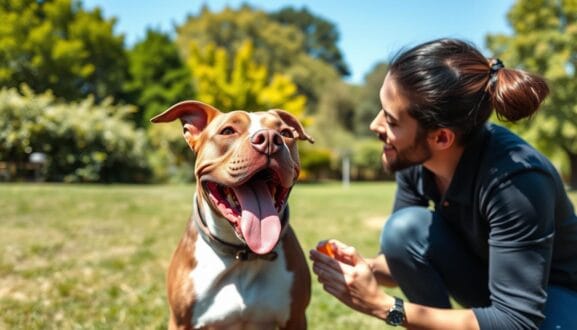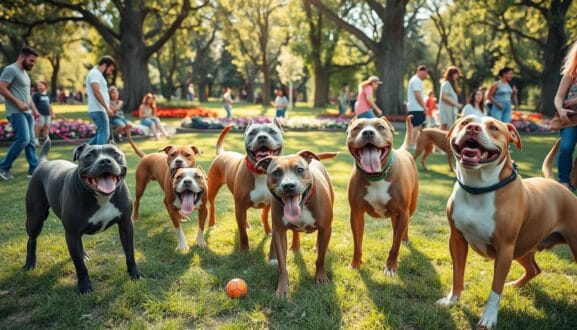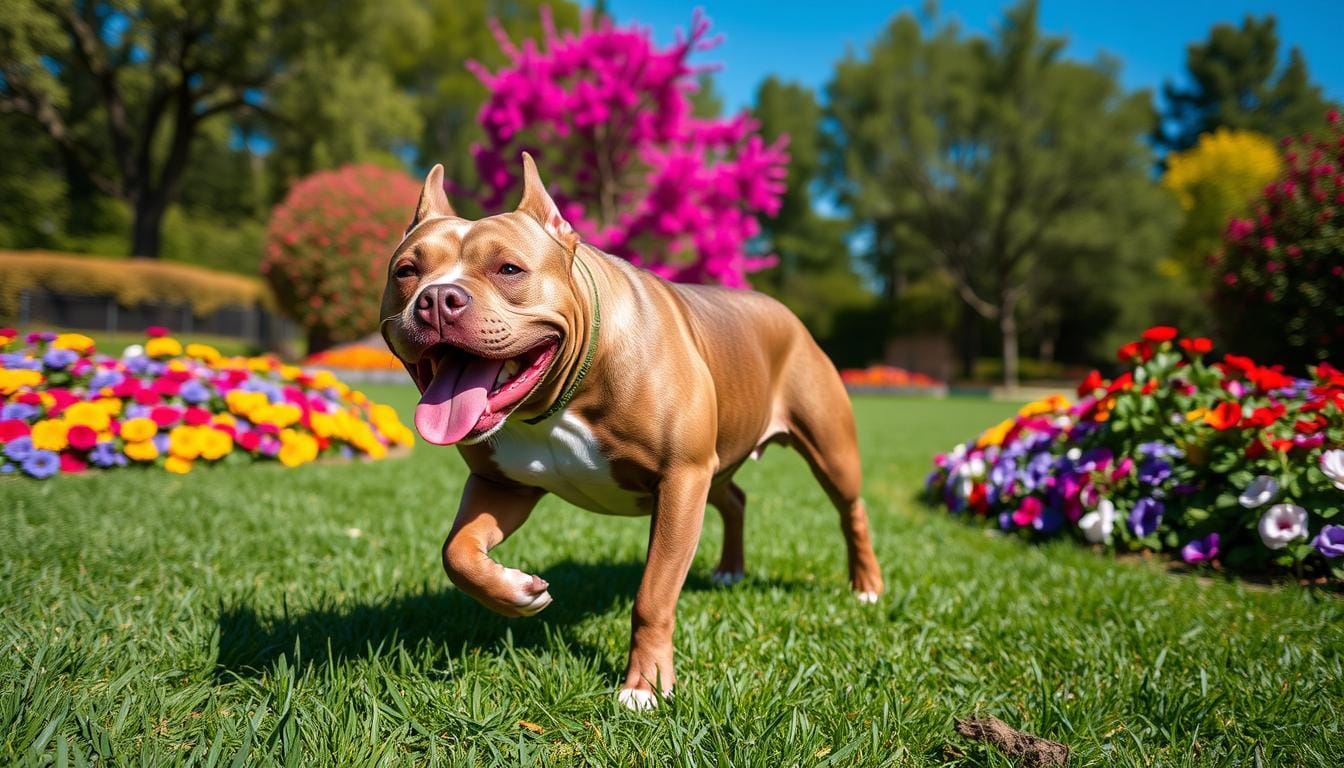As a dog owner, you know how much joy and companionship dogs bring. Have you thought about getting a pitbull? These dogs are often misunderstood, but they are loving, loyal, and very affectionate. This guide will help you understand pitbull dogs better, clearing up common myths and helping you decide if they’re right for you.
Pitbull dogs have a rich history, but it’s often filled with misinformation. We’ll look into their background, physical traits, and unique temperament. You’ll learn about different pitbull breeds, how to care for them, and legal issues related to owning a pitbull in your area.
This guide is for both seasoned dog owners and those thinking about getting their first dog. It will give you the knowledge and tools to understand pitbull dogs better. Let’s explore why these dogs are special and why they deserve love from dog lovers everywhere.
- Understanding the True Nature of Pitbull Dogs
- The Distinctive Physical Characteristics of Pitbulls
- Pitbull Temperament: What to Expect from Your Pet
- Essential Training Tips for Your Pitbull
- Health Care and Maintenance Requirements
- Socializing Your Pitbull: Best Practices and Tips
- Legal Considerations and Breed-Specific Legislation
- Creating the Perfect Home Environment
- Adopting vs. Buying: Making the Right Choice
- FAQ:
- What is a pitbull famous for?
- Is Pitbull a calm dog?
- Can a pitbull be a house dog?
- Why is pitbull banned in 12 countries?
- Does Germany allow pit bulls?
- How to identify a pitbull?
- What are some common misconceptions about pitbulls?
- What are the distinctive physical characteristics of pitbulls?
- What are the essential training tips for pitbulls?
- What are the common health issues in pitbulls?
- How can I properly socialize my pitbull?
- How can I create the perfect home environment for my pitbull?
Understanding the True Nature of Pitbull Dogs
Pitbull dogs have a rich history filled with misconceptions and stereotypes. To truly understand these loving companions, we must explore their origins and debunk common myths. This includes their temperament and behavior.
History and Origin of the Breed
The term “pitbull” includes several breeds like the American Pit Bull Terrier, American Staffordshire Terrier, and Staffordshire Bull Terrier. Originally bred in the 19th century for bull and bear baiting, they have evolved into loyal and affectionate family pets.
Common Misconceptions Debunked
Pitbull dogs are not inherently aggressive or dangerous. Studies show their temperament is similar to other breeds. With proper training and socialization, pitbulls can be wonderful companions for all ages, including children.
Different Pitbull-Type Breeds
- American Pit Bull Terrier
- American Staffordshire Terrier
- Staffordshire Bull Terrier
These breeds, often called “pitbulls,” share a similar heritage and physical traits. Yet, each has its own unique personality and temperament. Knowing the differences between these pitbull-type breeds is key for potential owners to make the right choice.
“Pitbulls are often misunderstood, but they are loving, loyal, and affectionate dogs when properly trained and socialized.”
| Breed | Origin | Temperament |
|---|---|---|
| American Pit Bull Terrier | Developed in the United States in the 19th century | Confident, energetic, and affectionate |
| American Staffordshire Terrier | Developed in the United States in the early 20th century | Loyal, gentle, and eager to please |
| Staffordshire Bull Terrier | Originated in Staffordshire, England in the 19th century | Friendly, intelligent, and courageous |
The Distinctive Physical Characteristics of Pitbulls
Pitbull dogs are renowned for their athletic and sturdy body. They have a broad, powerful head and a sturdy body. Their short, smooth coat comes in many colors and patterns. Knowing about the pitbull breed is key for any owner.
Pitbulls have a broad, square head, often called “blocky.” This strong head comes from their genetics and makes them look powerful. They also have a muscular, stocky body with a deep chest and well-defined muscles.
| Physical Characteristic | Male Pitbull | Female Pitbull |
|---|---|---|
| Height | 18-21 inches | 16-19 inches |
| Weight | 35-65 pounds | 30-50 pounds |
| Coat Colors | Solid, brindle, or a combination of colors, including red, blue, white, black, and tan | |
Pitbulls have a short, smooth coat that’s easy to groom. Their coats can be solid, brindle, or a mix of colors. Despite their tough look, pitbull dogs are loving and affectionate when trained and socialized.
The unique physical traits of pitbulls, like their muscular build and broad heads, make them stand out. Understanding these traits helps potential owners decide if a pitbull breed is right for them.
Pitbull Temperament: What to Expect from Your Pet
Pitbull dogs often face misconceptions about their temperament. But, they are intelligent and loyal, making great family pets with the right care. Let’s look at what makes pitbulls special and what you can expect from them.
Natural Personality Traits
Pitbulls are very affectionate and eager to please. They are smart and learn well with positive training. They love being around people and can form strong bonds.
They are also very loyal and protective, making them good guard dogs. But, they are not aggressive.
Behavior Around Children and Other Pets
Pitbulls can be great with kids if socialized and trained right. They are patient and gentle, loving to play and cuddle. But, always watch them with young kids for safety.
With other pets, pitbulls can get along well. But, be careful when introducing them to new animals.
Signs of a Well-Adjusted Pitbull
- Friendly and outgoing demeanor
- Calm and responsive to commands
- Comfortable in a variety of social situations
- Lack of aggression or excessive barking
- Healthy appetite and regular exercise habits
Understanding the pitbull temperament and training them right ensures they are well-adjusted. This way, your pitbull behavior will be great, and they’ll be a cherished family member.
Essential Training Tips for Your Pitbull
Effective pitbull training is key for a well-behaved, socialized, and happy pet. Positive reinforcement can help your pitbull to become a affectionate and obedient pet. This makes your home happier.
Early socialization is vital in pitbull training. Introduce your pup to many people, animals, and places early. This helps them adjust well and feel confident. It also helps prevent pitbull behavior problems later.
Learning basic commands like sit, stay, come, and heel is important. These skills make your pitbull easier to handle and strengthen your bond. Regular, patient training will show great results.
- Use treats and praise to encourage good behavior.
- Be patient and consistent, as pitbulls respond well to positive encouragement.
- Sign up for obedience classes or work with a professional trainer for proper socialization and to address any behavior issues.
By putting effort into pitbull training, you ensure your pet’s happiness and build a lifelong bond.
“The key to successful pitbull training is patience, consistency, and a focus on positive reinforcement. With the right approach, these loving companions can become well-behaved family members.”

Health Care and Maintenance Requirements
As pitbull owners who are passionate is essential to understand the health issues pitbulls face. Pitbulls are energetic and loving, but they face certain health issues. These need careful attention and care.
Common Health Issues
Hip dysplasia is a big concern for pitbull health. It causes pain and makes it hard for them to move. Skin allergies are also common, leading to itchy, irritated skin that needs special treatment.
Preventive Care and Regular Check-ups
Regular vet visits are vital for catching health problems early. Your vet can help with preventive care like shots, dental cleanings, and keeping parasites away. This keeps your pitbull happy and healthy.
Nutrition and Exercise Needs
- A high-quality, protein-rich diet is key for your pitbull’s muscle and health.
- Pitbulls need lots of exercise, like walks, playtime, and training. This keeps them fit and prevents bad behavior.
Understanding and meeting your pitbull’s health and care needs is crucial. This way, your furry friend can live a long, happy life with your family.
Socializing Your Pitbull: Best Practices and Tips
Proper socialization is key for a well-adjusted pitbull. Early and ongoing exposure to new things can shape your pet’s pitbull behavior and temperament. By following these tips, your pitbull will become confident and well-rounded.
Begin socialization early, right after bringing your pitbull home. Introduce your pup to various sights, sounds, and experiences in a positive way. Reward calm and friendly behavior to build confidence and trust.
- Enroll your pitbull in socialization classes or puppy play groups for structured interactions.
- Take your pitbull on regular walks and visits to pet-friendly places like parks or pet stores.
- Encourage positive interactions with family, friends, and neighbors to help your pitbull feel comfortable around new people.
Pitbull socialization is a lifelong process. Keep exposing your dog to new situations and experiences. Always reinforce calm and friendly behavior. This will help your pitbull become a well-adjusted companion.
“Proper pitbull socialization is the key to unlocking their true potential as loving, loyal family members.”

By focusing on pitbull socialization and following these tips, you’ll have a confident, well-behaved pitbull. Remember, with the right care, these misunderstood pups can be wonderful, affectionate companions.
Legal Considerations and Breed-Specific Legislation
As a pitbull owner, knowing the legal rules is key. Breed-specific laws (BSL) change a lot from place to place. It’s vital to know the laws in your area.
Understanding Local Laws
Some places have laws that limit or ban pitbulls and similar breeds. These laws might ask for muzzles, special licenses, or certain rules for where the dog can be. Make sure you check the laws in your city or state to keep your pitbull safe and legal.
Insurance and Housing Considerations
Having a pitbull can make getting insurance and finding a place to live harder. Some insurance companies won’t cover pitbulls, or they might charge more. Also, some places to live might not allow pitbulls, making it tough to find a home.
Advocacy and Resources
If pitbull laws or pitbull ownership issues are a problem, there’s help out there. Groups like the American Pit Bull Foundation and the Pit Bull Advocacy Network offer support. They can help you understand the laws and fight for fair policies.
By staying informed and active, you and your pitbull can live a happy, legal life together.
Creating the Perfect Home Environment
As a pitbull owner, it’s key to create a great living space for your pet. These loyal dogs need a home that meets their needs and encourages their natural pitbull behavior.
First, think about your pitbull’s safety. Make sure their home is safe and free from dangers like sharp edges or loose furniture. Give them sturdy, chew-resistant toys and enough room to move around.
Mental stimulation is as important as physical exercise for your pitbull ownership. Use interactive puzzle toys, hide-and-seek games, and various activities to keep their mind sharp. Change their toys often to keep them interested and prevent boredom.
| Essential Home Items for Pitbulls | Quantity |
|---|---|
| Sturdy Chew Toys | 3-5 |
| Interactive Puzzle Toys | 2-3 |
| Durable Beds | 1-2 |
| Non-Slip Mats | 2-3 |
Pitbulls are very energetic and need lots of exercise to stay healthy. Create a safe, fenced area or go for walks to keep them active. Play games that challenge their problem-solving skills, like agility training or hide-and-seek.
By making a safe, fun, and enriching home, you’ll give your pitbull the best place to thrive. They’ll become a well-adjusted, loving companion.
Adopting vs. Buying: Making the Right Choice
Welcoming a pitbull dog into your life can be done in two ways: adopting or buying. Each option has its own benefits. The right choice for you depends on your situation and what you prefer.
Rescue Organizations
Adopting a pitbull from a rescue is very rewarding. These groups help find homes for pitbulls in need. They also check the dog’s health and behavior to make sure it’s a good match.
By adopting, you save a life and help the pitbull community. It’s a great way to make a difference.
What to Look for in a Reputable Breeder
If you want to buy a pitbull, finding a good breeder is key. A good breeder cares about the health and personality of their dogs. They should give you health records and explain how they breed.
They should also answer all your questions and help you prepare for your new pet.
Preparing for Your New Pet
Getting ready for a pitbull dog is important, whether you adopt or buy. You need to know the local laws, have the right home, and insurance. Make sure you have enough time, energy, and resources for your new pet.
With the right preparation, you’ll enjoy a great experience with your pitbull dog.
FAQ:
What is a pitbull famous for?
Pitbull dogs are famous for their strength, determination, and loyalty. Historically bred for bull-baiting and farm work, they have a reputation for being courageous and protective. Despite misconceptions, pitbull dogs are often affectionate companions, known for their playful and loving nature when raised in a positive environment.
Is Pitbull a calm dog?
Pitbull dogs are often mischaracterized as aggressive, but they can be quite calm and affectionate when properly trained and socialized. Known for their loyalty, they are typically friendly and good-natured with their families. Regular exercise and positive reinforcement help ensure that pitbull dogs remain calm and well-adjusted companions.
Can a pitbull be a house dog?
Yes, pitbull dogs can make excellent house pets when properly trained and socialized. Known for their loyalty and affection, they are often good with families and children. However, they require consistent exercise, mental stimulation, and firm leadership to ensure they remain well-behaved and balanced within the home environment.
Why is pitbull banned in 12 countries?
Pitbull dogs are banned in 12 countries due to concerns about their perceived aggression and strength. These breeds are often involved in incidents of attacks, leading to fear and legal restrictions. However, many advocates argue that with proper training and socialization, pitbull dogs can be friendly and safe companions.
Does Germany allow pit bulls?
In Germany, the ownership of pitbull dogs is regulated. While they are not outright banned nationwide, several regions impose restrictions on the breed due to concerns about aggression. Owners may need to meet specific criteria, such as obtaining a special permit or demonstrating proper training and socialization for the dog.
How to identify a pitbull?
To identify pitbull dogs, look for a muscular build, broad chest, and strong jaw. They typically have a short coat, which can come in various colors. Their ears are often medium-sized and can be floppy or semi-erect. Pitbulls are known for their athleticism and confident demeanor, making them easily recognizable.
What are some common misconceptions about pitbulls?
Many people think pitbulls are always aggressive. But this isn’t true. Pitbulls are a group of breeds, each with its own traits. With the right training, they can be great family pets.
What are the distinctive physical characteristics of pitbulls?
Pitbulls have a strong build, broad head, and short coat. They come in many colors and sizes. Males are usually bigger than females.
What are the essential training tips for pitbulls?
Training pitbulls should use positive methods, start early, and address bad behaviors. Consistent training helps them become well-adjusted.
What are the common health issues in pitbulls?
Pitbulls can get hip dysplasia and skin allergies like other breeds. Regular vet visits and care are key to keeping them healthy.
How can I properly socialize my pitbull?
Socializing your pitbull early is vital. Introduce them to new people, animals, and places in a positive way. This helps them become confident and well-adjusted.
How can I create the perfect home environment for my pitbull?
A good home for your pitbull has safety features, the right equipment, and chances for exercise and mental play. A safe and stimulating environment is key for their happiness.
Share your thoughts in the comments below! If you enjoyed this post, consider subscribing to our newsletter for more pet tips, stories and blogs!

